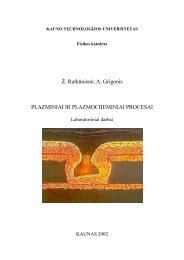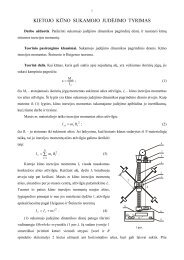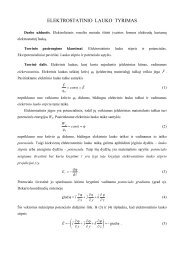PROCEEDINGS OF THE 7 INTERNATIONAL ... - Fizika
PROCEEDINGS OF THE 7 INTERNATIONAL ... - Fizika
PROCEEDINGS OF THE 7 INTERNATIONAL ... - Fizika
Create successful ePaper yourself
Turn your PDF publications into a flip-book with our unique Google optimized e-Paper software.
G. Adlys / Medical Physics in the Baltic States 7 (2009) 86 - 90<br />
The values of total cross-section for stable boron and<br />
gadolinium nuclides corresponding to three different<br />
neutron energies are presented in Table 1.<br />
Table1. Total cross-section values, barns (1 b = 1⋅10 -24<br />
cm 2 )<br />
Nuclide Thermal<br />
neutrons<br />
0.025 eV<br />
Fission<br />
neutrons<br />
Fusion<br />
neutrons,<br />
14 MeV<br />
B10 3840 2.638 1.467<br />
B11 5.05 2.425 1.415<br />
Gd152 1070 7.003 5.699<br />
Gd154 92.35 6.981 5.697<br />
Gd155 60948 6.981 5.694<br />
Gd156 6.995 6.983 5.694<br />
Gd157 255085 6.979 5.696<br />
Gd158 6.354 6.978 5.694<br />
Gd160 4.904 6.983 5.699<br />
It is clearly seen that the biggest neutron interaction<br />
cross-section is for thermal neutrons (first column)<br />
interacting with nuclides 10 B, 155 Gd, 157 Gd.<br />
The reaction products are gamma photons, protons,<br />
alpha particles. The corresponding reactions are (n,γ),<br />
(n,p), (n,α). The values of above-mentioned reactions<br />
cross-sections for thermal neutrons are presented in<br />
Table 2.<br />
Table2. Reaction cross-section (0.025 eV), barns<br />
Reaction B10 Gd155 Gd157<br />
(n,γ) 5.00E-03 60889 254078<br />
(n,α) 3.84E+03 8.18E-05 4.78E-04<br />
(n, p) 3.00E-03 0 0<br />
Analysis of reaction cross-section values and<br />
comparison with values of total cross-section shows that<br />
for 10 B nucleus alpha particle emission has 99.9 %<br />
probability and very small gamma photon and proton<br />
emission probability.<br />
During the neutron capture reaction nucleus of Boron<br />
10<br />
B absorbs neutron and two charged particles are<br />
produced:<br />
10<br />
4 7<br />
B + n → He + Li<br />
Inverse situation is for thermal neutron capture by<br />
Gadolinium reaction. Probability of alpha emission<br />
during reaction with neutrons is very small. Almost all<br />
reactions are radiative neutron absorption which<br />
produces γ photons and higher gadolinium isotopes:<br />
155<br />
156<br />
Gd + n → Gd + γ<br />
157<br />
158<br />
Gd + n → Gd + γ<br />
New reaction products 156 Gd and 158 Gd are stable.<br />
At present, the most studied and used in clinical practice<br />
is Boron neutron capture therapy (BNCT). This method<br />
is based on the radiation damage produced by high LET<br />
particles (α and 7 Li) emitted in the 10 B neutron capture<br />
10<br />
7<br />
reaction: B(<br />
n,α<br />
) Li . The total kinetic energy of<br />
charged particles produced is approximately 2,4 MeV.<br />
A range of these charged particles in a tissue is<br />
88<br />
approximately of the order of the size of tumor cell.<br />
These high linear energy transfer particles dissipate<br />
their kinetic energy in the cell. As a result, the cell<br />
comprising 10 B during neutron irradiation is effectively<br />
destroyed. Because of higher concentration of 10 B<br />
isotope in the tumor cells mainly the cancer cells are<br />
destroyed. Thus, the basic idea of BNCT is that a<br />
neutron ,,finds” out the tumor cells and destroys them<br />
[4]. Therefore, selective delivery of boron and high<br />
accumulation into tumor tissue achieving the range of<br />
20-35 μg g -1 are the most important requirements for<br />
efficient neutron capture therapy of cancer [7]. It could<br />
be realized using specific borated compounds. 10 B<br />
isotope compose only one fifth from total naturally<br />
occurring boron mass. Therefore the boron containing<br />
compounds are 10 B enriched and synthesized. If<br />
introduces into the patient’s blood this compound<br />
produces 10 B isotope in the tumor cell with a<br />
concentration of 30 μg g -1 while the concentration of<br />
boron in surrounding normal tissue cells is<br />
approximately 10 μg g -1 [2].<br />
5. The requirement for the neutron beam for<br />
neutron therapy<br />
The use of boron neutron capture therapy (BNCT) for<br />
the treatment of deep-sealed tumors requires neutron<br />
beams of suitable energy and intensity [8].<br />
The thermal neutrons are most intensively absorbed by<br />
10 B, but they weakly penetrate the tissue and therefore<br />
produce the major radiation load on the surface layers,<br />
primarily on the skin. If the cancer tumor is located<br />
under the normal tissue at the depth of 30-70 mm,<br />
neutron energy should be ranged from 1 eV to a few<br />
tens of keV [8]. This is the energy range of epithermal<br />
neutrons, just above thermal. Epithermal neutrons<br />
passing through the normal tissue layers are slowing<br />
down, gradually establishing thermal equilibrium with a<br />
tissue. It results in the peak of the thermal neutron flux<br />
in the deep tissue and could provide the maximum of<br />
absorbed dose in the irradiated deep scatter tumors.<br />
Fast neutrons as compared to epithermal neutrons<br />
produce radiation effects in the tissue by recoiling<br />
protons and have no selective character.<br />
The required absorbed radiation dose in a single<br />
treatment and desirable exposition duration are the<br />
factors for choosing of the intensity of a neutron beam.<br />
It was shown [8] that for10 min exposition, for attaining<br />
an absorbed dose of 20 Gy in the tumor with the 10 B<br />
concentration of 30 μg g -1 the required epithermal<br />
neutron flux has to be from the range of (0,5-1)x10 10<br />
cm -2 s -1 . If neutron flux is reduced than to attain the<br />
same absorbed dose it is possible by an increase in 10 B<br />
concentration in the tumor or by the extension of the<br />
irradiation time. However it is to point out, that the<br />
absorbed dose produced by fast neutrons and by<br />
accompanying gamma-rays should non exceed 10 % of<br />
the therapeutical dose, i.e. 2 Gy.<br />
The neutron spectrum for fast neutron therapy should be<br />
similar to the neutron spectrum of uranium fission [2].<br />
In this case a fraction of neutrons with the energy over








